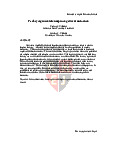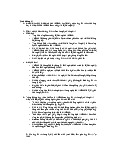




Preview text:
Nature of assessment: Group Project
Word limit: 5,000 words (+/- 10%) excluding executive summary, tables, and reference list
Due date: Sunday, 25th June (before midnight)
Submission: Turnitin submission on Mlearning is compulsory.
Late penalty: 10% of the total mark for every 24 hours of late submission (includes the weekend)
------------------------------------------------ The Assignment
A digital marketing plan outlines how a business will achieve its desired goals
through digital marketing strategies, tactics and channels. Without a digital
marketing plan, businesses run the risk of their digital marketing efforts and
investments not aligning with their overall business strategy. For this
assignment you are required to select a small to medium sized business, and
to provide the management of that business with a detailed digital marketing
plan. Being the major assignment for this unit, it is expected that you put the
concepts and tools you have learned throughout the entire course of this unit into practice. What you need to do
1. Digital marketing plan development
Work through the following steps to develop a digital marketing plan for the
business you have chosen. The plan should make use of appropriate digital
marketing frameworks, models and theories we learn throughout semester to
provide structure and support your content. Step 1: Situation analysis
The first step involves a situation analysis of the operating
environment, industry, business, and its current digital presence. Focus on addressing the following:
Briefly introduce the business and describe the industry in which it operates.
Provide a critical analysis of current digital trends in the
industry, including competitors, customers, suppliers, intermediaries, etc.
Provide a critical analysis of the current
business goals, marketing strategies, digital strategies and tactics (or lack thereof!)
Analyse and describe the brand’s target audience including
audience personas and their customer journeys.
Based on your analysis, identify key areas where the customer
experience can be improved using digital
technologies across different touchpoints
Hint 1: To structure your analyses, you should use marketing models and
frameworks we have covered this semester (i.e. macro, meso, and micro
analysis frameworks, digital marketing audit, audience personas, customer
journeys, SWOT etc.). Which ones you use is up to you and should be
determined by your business and the environment it operates in.
Hint 2: You are expected to use relevant sources to provide evidence of your
analysis. Although you should reference any academic articles you use, it is
expected that the majority of sources for this section come from industry
reports, industry articles, online articles, and any data, graphs or charts you
can find from reputable sources. You can also use your own experiences and
observations with the business, or conversations with its owners as evidence as well.
Hint 3: The entire point of this section is to generate some insights into
possible opportunities and key areas for improvement. If you get to the end
of this section, and you do not have clear opportunities and areas for
improvement identified, you need to go back and conduct more in-depth and critical analysis. Step 2: Establish objectives
Based on the market analysis and insight generated in step 1, you will need
to formulate your digital marketing objectives. Important points:
Formulate exactly three digital marketing objectives
Your digital marketing objectives need to align with your overall
business goals you identified in Step 1
Digital marketing objectives can be short, medium or long term
Everything after this point in your plan should work
towards achieving these digital marketing objectives
Hint 1: Develop your digital marketing objectives using the SMART
framework: Specific, Measurable, Achievable, Relevant, and Time-bound
Hint 2: Clearly link your objectives to your market analysis and insights from step 1.
Hint 3: From this point, everything you do in the rest of the report should be
designed to align to the objectives you set in this section.
Step 3: Formulate strategy and tactics
Formulate one digital strategy (including tactics and channels) to achieve
each objective you have outlined in step 2.
For each strategy, include the following:
A description of the strategy, and the specific tactics and channels that will be used.
An evidence-based justification of how this strategy adds value to
the business and its customers.
A clear and realistic action plan including specific tasks, timeframes,
responsibilities, and budgetary considerations.
A description of how this could be linked to traditional marketing initiatives to build synergy.
Your digital marketing strategies should be:
Clearly linked to the opportunities and improvement areas identified in Step 1.
Clearly linked to your digital marketing objectives from Step 2.
Supported by evidence that justifies their selection (you need to
provide evidence that will convince the business to implement that strategy).
Tailored to the target audience’s persona and customer journey.
Hint 1: This assignment is about digital marketing, so please make sure you
recommend digital marketing strategies. Only suggesting non-digital
strategies and tactics is not acceptable.
Hint 2: Although you should reference any academic articles you use, it is
expected that the majority of sources for this section come from industry
reports, industry articles, online articles, and any data, graphs or charts you
can find from reputable sources.
Hint 3: Use the planning tools and frameworks we learn about in your online
lessons, including the planning table that allows you to summarise your
objectives, strategies, tactics and channels. Step 4: Measure r esults
The final step involves suggested measurement of the results to determine
success or failure, as well as opportunities for improvement. For each objective:
Choose one Key Performance Indicator (KPI) and justify, with
evidence, why this is the correct metric to measure success
Describe how and where the data for the KPI will be collected
Hint: Select metrics that we have discussed in your lessons this semester.
Your metrics should be digital marketing metrics specifically. Recommended structure:
Your digital marketing plan should be presented in a business report format
and include numbered headings, such as the following: Executive summary Table of contents Introduction Situation analysis Objectives
Strategies, tactics and channels Performance measurement References
Your work should be supported by evidence from a range of sources. The
more relevant evidence you provide, the better. Reports with less than five
sources (industry reports, industry articles, academic papers etc.) are
unlikely to be eligible for a pass.
The word limit is 5000 words (excluding the executive summary, tables,
and references). To fit within this word limit, you should focus only on crucial
information, write succinctly, and use charts, tables and graphics to present analysis and evidence.




